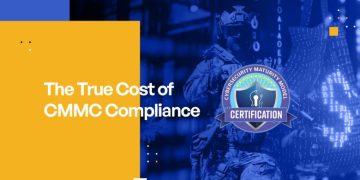A strong defense system isn’t just built with aircraft, ships, or tanks—it’s also built with data. While that may sound abstract, the digital networks behind government operations are just as targeted as any battlefield. That’s why cybersecurity standards like CMMC are more than checklists—they’re deeply tied to national security.
Rising Threat Landscape Accelerates DoD Emphasis on CMMC Compliance
Nation-state attacks and cybercriminal groups have shifted their focus to defense contractors—not just the big names, but subcontractors too. These bad actors know that smaller vendors often hold sensitive data and don’t always have strong security controls. This increase in targeting pushed the Department of Defense to move forward with standardized cybersecurity expectations through structured CMMC compliance requirement. It’s no longer just a suggestion—it’s a national defense necessity.
Even contractors only handling Federal Contract Information (FCI) must meet CMMC level 1 requirements, while others working with Controlled Unclassified Information (CUI) need to pursue CMMC level 2 compliance. The Department of Defense has made it clear: protecting data at all levels is vital. Recognized third-party assessors, known as c3pao professionals, now play a key role in ensuring companies meet these evolving expectations.
Reasons Controlled Unclassified Information (CUI) Protection Drives CMMC Requirements
CUI isn’t top secret, but it can still pose a national risk if mishandled. Engineering specs, communication details, and logistics data fall under this category. These aren’t secrets in the traditional sense, but they can give adversaries insight into U.S. capabilities, project timelines, and vulnerabilities. That’s why protecting CUI is central to the structure of CMMC compliance requirements.
To safeguard this data, CMMC level 2 requirements build on the basics of level 1 by introducing stricter controls such as multi-factor authentication, encrypted communications, and documented security policies. For companies aiming to win or maintain contracts involving CUI, working with a registered CMMC RPO helps ensure those practices are not only implemented but align with assessment guidelines enforced by a c3pao.
National Security Risks Triggering Elevated CMMC Adoption
Breaches at the contractor level can ripple through the entire Department of Defense supply chain. A single weak link opens the door for surveillance, intellectual property theft, or worse. These risks prompted the federal government to increase oversight and enforce CMMC implementation as a proactive measure.
Rather than react after damage is done, CMMC establishes a clear path to prevent breaches before they happen. As risks grow more sophisticated, the urgency around meeting CMMC level 2 compliance becomes more pronounced. With foreign entities targeting even low-level suppliers, the DoD’s support of standardized certification through third-party c3pao assessments isn’t just smart—it’s essential.
What Makes Supply Chain Integrity Essential to National Defense Under CMMC
A secure defense system depends on the trustworthiness of every part of its supply chain. That includes small subcontractors providing software, parts, or specialized services. If even one supplier fails to meet the necessary security controls, it can put the entire project at risk. CMMC compliance requirements were developed to address that weakness.
By implementing CMMC level 1 requirements for basic access and CMMC level 2 requirements for those handling CUI, the Department of Defense is closing the door on potential vulnerabilities. This system ensures that no matter how deep a company sits in the chain, they’re operating under the same minimum standards. Working with a CMMC RPO allows businesses of all sizes to keep pace with these expectations and prepare for formal certification by a c3pao.
Latest Information: Celebjihad
Defense Contract Continuity Heavily Depends on CMMC Enforcement
No business wants to be caught off guard during contract renewal season. But without meeting CMMC requirements, companies risk being dropped from government work altogether. This shift isn’t theoretical—it’s already being implemented into contract language and RFPs. Contractors who can’t prove compliance simply won’t be eligible for award.
That’s why preparation matters. Whether you’re new to government work or a seasoned contractor, achieving CMMC level 2 compliance ensures long-term stability in defense partnerships. For many businesses, this involves working with a qualified CMMC RPO to identify gaps, build a roadmap, and prepare for assessment by an accredited c3pao.
DoD’s Focus on Risk Mitigation Influences Mandatory CMMC Compliance
The Department of Defense views cybersecurity not just as IT policy, but as active risk management. From espionage threats to ransomware, the stakes are high—and the risks are evolving fast. By making CMMC a mandatory part of contract eligibility, the DoD is reducing the chance that its partners become security liabilities.
CMMC level 1 and level 2 requirements reflect this priority. They include clear, enforceable practices like restricting access, monitoring usage, and securing endpoints. Organizations are expected to prove they’re actively managing risks, not just reacting after the fact. A CMMC RPO provides the technical insight to implement these protocols properly, while a c3pao ensures they’re met to the letter.
Strategic Advantages Achieved by Robust CMMC Compliance Implementation
Beyond satisfying contract requirements, companies that embrace CMMC compliance gain real operational benefits. Stronger security translates into fewer incidents, smoother audits, and higher client confidence. It also opens the door to more competitive defense contracts that demand higher levels of cybersecurity assurance.
By meeting CMMC level 2 compliance early and thoroughly, businesses position themselves as reliable long-term partners. Certification from a c3pao signals to the DoD that your systems can be trusted. Plus, partnering with a CMMC RPO ensures your company builds a security posture that stands the test of time, scaling alongside threats and opportunities alike.












